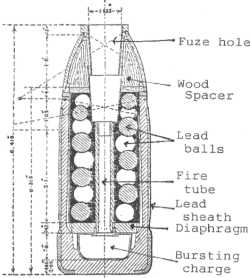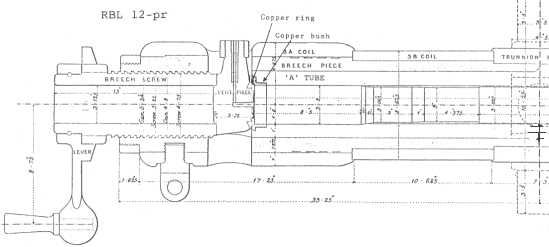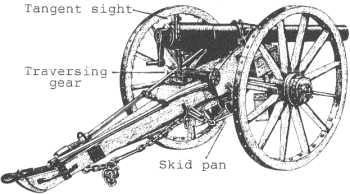The Gun - Rifled Ordnance: Armstrong
The term RBL was given to Armstrong guns in later years to distinguish them from the 'BL' types introduced from 1880. Armstrong OrdnanceThe gun was of 'built-up' construction consisting of an 'A' tube comprising the bore over which were shrunk a breech piece, trunnion ring, and smaller tubes. Material was wrought iron. | |
|
Rifling was a well-designed poly-groove 'hook section' type. It consisted of 38 grooves with a uniform twist of one turn in 38 calibres. Calibre was 3-inch (76.2 mm). |
Section of rifling |
|
A feature usually associated with World War 2 guns was its 'squeeze bore' which Armstrong called a 'grip'. The last six inches of the bore at the muzzle was slightly reduced in diameter, the purpose being to ensure precise centring of the projectile before it left the gun. At the same time it swaged down the lead sheathing slightly reducing the diameter and thus improving its ballistic shape. | |
BreechIn the original 12-pr 8-cwt gun, later known as the 'old pattern', OP, the length of the piece was 84 inches (2.14m), but as the Navy wanted a shorter gun a 'new pattern' was introduced by cutting 12.125 inches (30.8 cm) off the muzzle ends of OP guns, thus eliminating the 'grip'. As might be expected this modification markedly reduced the efficiency of the 12-pr. Breech closure was effected by a vertical sliding block of rectangular section called a vent piece. Obturation was achieved by a conical copper-ringed plug on the face of the vent piece being forced into a copper bush at the mouth of the chamber shaped to receive it, rather like a cork in a bottle. Plug and ring were held tightly together by a hollow breech screw through which the gun was loaded. Both the rear end of the breech screw and its handle were fitted with tappets to assist in tightening the assembly. To load, the vent piece was lifted clear. The projectile was then rammed through the breech screw until stopped by the shot seating, followed by the cartridge. The vent piece was then replaced and the breech screw tightened, after which a friction tube was inserted in the vent. Lastly, a lanyard was hooked to the ring on the tube. |
 System of obturation
|
SightsUntil the 20th century sights on British field guns were attached directly to the piece. On Armstrong guns simple battle sights were provided on breech and trunnion ring, while for normal laying on the 12-pr a tangent sight was fitted to a removable carrier clamped to the rear of the breech piece. The socket was inclined 2° 16' to the left to provide a mean correction for drift. Although the sight was graduated to 3400 yards (3109m) only, the gun was capable of much more. However, the pole-type trail limited elevation to about 12° thus limiting the range. Nevertheless, the equipment more than satisfied the tacticians of the day whose thinking had advanced little since Waterloo. The only range table now available ends at 8° 20' with a range of 3000 (2743m).
CarriageArmstrong's prototype 12-pr field carriage incorporated a central pivot type saddle with screw and nut traversing gear similar to those on modern field guns but was rejected as too heavy and too expensive. It was also fitted with a simple recoil mechanism in which the gun recoiled up a sloping ramp and ran out under gravity, but this was turned down for the same reasons. To save money the authorities ordered old wooden SBML 9-pr carriages to be used for the Armstrong 12-prs, a step which proved to be false economy because the greater power of the new gun broke many trails near the elevating gear bed-plate. Replacement was both expensive and time consuming. The 12-pr was the first British field gun to be fitted with a traversing gear. Unfortunately, adapting it to the old 9-pr carriages made it rather complicated - and expensive - and limited top traverse to only 1½° right and left. Still, it proved a boon to the old-time layers. AmmunitionUntil 1860 projectiles were of one type only, ie segment, intended to act as shot, common shell, or shrapnel, but separate types were introduced later. They were first galvanised, ie coated with zinc, then sheathed with lead up to the ogive. The lead effectively performed the same function as the modern driving band, ie forced the projectile to rotate with the rifling, and prevented the loss of propellant gas to the front. Segment ShellThis consisted of a thin cast iron case shaped to leave a central hole for the bursting charge. Segments of cast iron weakened internally by grooves to assist fragmentation were inserted from the rear of the shell which was closed by a cast iron disc. During the application of the lead sheathing the molten lead was permitted to flow between the segments thus binding them together, while at the same time securing the base disc to the body of the shell. Thus the shell was made strong against external pressure but opened readily when the bursting charge was exploded. Mainly used as an anti-personnel weapon, it was fuzed with either a time or 'concussion' (later termed 'percussion') fuze. Segment was superceded by common shell and shrapnel. | |
Armstrong's ShrapnelArmstrong's shrapnel closely resembled the shrapnel of later guns. The shell consisted of a thin iron casing filled with lead balls set in rosin with space for a central fire tube running from fuze to bursting charge contained in a tin cup in the base. Officers recommended it be burst 50 yards (46 m) short of the target, and 10-15 feet (3-4½ m) above it for best effect. Shrapnel was once considered the best mankiller the field artillery possessed, and from the 1880s until 1915 was the sole projectile carried besides case. In 1915 it was largely supplanted by HE which was cheaper and easier to employ. Shrapnel became obsolete in the British service in 1935 - although it was still being used in New Zealand in the 1940s. Gunners soon realised that shrapnel fired with fuze set to zero acted as effectively as case so the latter ceased to be carried by field artillery. |
 |
CaseCase shot were provided for Armstrong guns. They differed little from those designed for ML and RML equipments except that they were fitted with a lead ring at the base to prevent their going too far on being rammed. CartridgesPropellant charges of gunpowder were fixed at one eighth the projectile's weight (except for the 7-inch which were slightly less) and were enclosed in serge bags. A 'lubricator' consisting of a cup of tallow and linseed oil was enclosed in each cartridge or attached to the outside of 40- and 110-prs (7-inch). Its purpose was to prevent the gun 'leading up', ie to stop the lead sheathing on the projectiles fouling the rifling. Tin CupsThese were inserted in the chamber after loading to assist obturation. Each had a hole in the centre to allow flash from the vent to fire the cartridge. They were used for practice only. IgnitionThis was by 'T' friction tube. Record of Service of Armstrong's RBL GunsGunners who have read the history of the Regiment know that in 1870 Britain reverted from RBL Ordnance to RML, a step now regarded as retrograde. Military historians on the whole attribute the dumping of the RBL guns to failure of the breech mechanisms. The question therefore arises, why were the faults not detected and rectified during the extensive trials the guns underwent before acceptance by the Ordnance Select committee responsible? After all, the Committee were said to have been greatly impressed by their service. First, it must be remembered that during the trials the guns were manned and maintained by detachments trained by the makers. Trouble began after they were issued to units and/or ships. We shall therefore examine the conditions then prevailing in the services. During the 1860s 60% of the rank and file were illiterate. Also, to the majority the working of even the simplest mechanical device was incomprehensible. Many of the NCOs were little better - and they did most if not all the instructing. Officers rarely instructed anyone. Many were prejudiced against breech-loading - or against any other 'new-fangled idea' for that matter, especially if invented by a civilian such as Armstrong. 'What was good enough for Grandfather is good enough for me', seemed to be the general attitude. The so-called 'scientific education' they received at Woolwich should have warned them to explain technicalities peculiar to the new guns to the NCOs so they could pass the information on to the Gunners, but evidently they failed to do so. They complained bitterly at having to re-write the Gun Drill '... because the gun loaded at the wrong end ...'. They went on to complain that '... the guns were so complicated that the ignorant Gunners would never, ever, learn how to handle them.' And it seems few made any attempt to teach them. In China, where the first 12-prs saw action in 1860, the guns were said to have performed well, but a certain Battery Commander complained that after a week's wet weather the breech screws became so stiff with rust that the rate of fire suffered. Apparently the 'scientific education' received at Woolwich did not mention that iron went rusty in the rain if not dried and oiled. Obviously he had neglected to see that his Gunners were trained in basic maintenance - or worse, that his NCOs were not 'on the ball'. The few faults that came to light early in the service of the Armstrongs were soon remedied. For example, occasional stripping of the lead sheath from projectiles when fired was cured by galvanising them before applying the lead. Of course the media avidly seized upon this complaint with loud condemnation of '... guns which were a menace to our own troops from pieces of flying metal ...' They did not explain to readers that soldiers were in no danger from guns at peace-time practice. Early wrought iron vent pieces sometimes gave trouble but were soon replaced by steel types which stood the strain better, and each gun carried a spare. The so-called failure of vent pieces, loudly trumpeted by the media, was invariably traced to bad drill, eg the No 2 not tightening the breech screw sufficiently - or by the No 1 not ensuring he did so by checking the indicator provided for the purpose. Of the 570 12-prs issued to RA units only 13 were ever returned to workshops for repair. Of these three were condemned while the rest were repaired at little cost. They gave excellent service in this country. Admittedly Armstrong breech mechanisms were crude by modern standards, but they worked reasonably well if properly maintained. The chamber and vent piece ring had to be kept scrupulously clean at all times; the slightest bit of dirt on either meant trouble. Also, wear had to be kept within strictly defined limits, a point not always brought home to the old-time artificers who were primarily blacksmiths, and who did not appreciate its importance. Thus faults lay more with the people responsible for the guns than with the guns themselves. Although Armstrong himself stated he did not believe his system suitable for guns heavier than field, so anxious were the Navy to re-equip they ordered 100 110-pr (7-inch) RBL guns without any trials of a prototype! Then when they found the heavy vent pieces extremely difficult to handle in a rough sea, they howled for the return of their old SBML 68-prs! Public confidence in Armstrong equipments declined as the media took few pains to distinguish between fact and fiction in their coverage of complaints. Prejudice raised its ugly head, MPs got into the act, questions were asked in the House, and the inevitable enquiry ensued. WL Ruffell, 1997
previous | index | next |
History index | Home
| |
 As his system was initially adopted in 1858 'for special service in the field', at first Armstrong produced the smaller equipments only, ie the 6-pr (2.5-in) mountain or light field, 9-pr (3-in) for horse artillery, and 12-pr (3-in) for field. Although he did not consider his system suitable for heavier guns defence chiefs later prevailed upon him to produce a 20-pr (3.75-in), a 40-pr (4.75-in) and a 110-pr (7-in), being field, siege and heavy pieces respectively. All except the 20-pr saw service in New Zealand, and all were used by the Navy in various sea-service roles. Apart from size they all looked very much alike and worked in the same way. As the 12-pr was without doubt the most successful and saw extensive service in this country we shall take it as an example for detailed study.
As his system was initially adopted in 1858 'for special service in the field', at first Armstrong produced the smaller equipments only, ie the 6-pr (2.5-in) mountain or light field, 9-pr (3-in) for horse artillery, and 12-pr (3-in) for field. Although he did not consider his system suitable for heavier guns defence chiefs later prevailed upon him to produce a 20-pr (3.75-in), a 40-pr (4.75-in) and a 110-pr (7-in), being field, siege and heavy pieces respectively. All except the 20-pr saw service in New Zealand, and all were used by the Navy in various sea-service roles. Apart from size they all looked very much alike and worked in the same way. As the 12-pr was without doubt the most successful and saw extensive service in this country we shall take it as an example for detailed study.


